It’s hard to beat a good hot hatch when it comes to covering all the bases. They tend not to cost the earth, or consume too many of its resources, while being both city and family friendly. You can delve deeper into their talents on road without going too bananas, and they acquit themselves well on track too. There are varying degrees of hatch hotness, ranging from the likes of the Fiesta ST up to the madness of the AMG A 45. Somewhere in the middle lie these two, the Ford Focus RS and the VW Golf R, the latter recently updated. We introduced them to each other in the hope they’d play nicely. Which do we prefer? Read on.
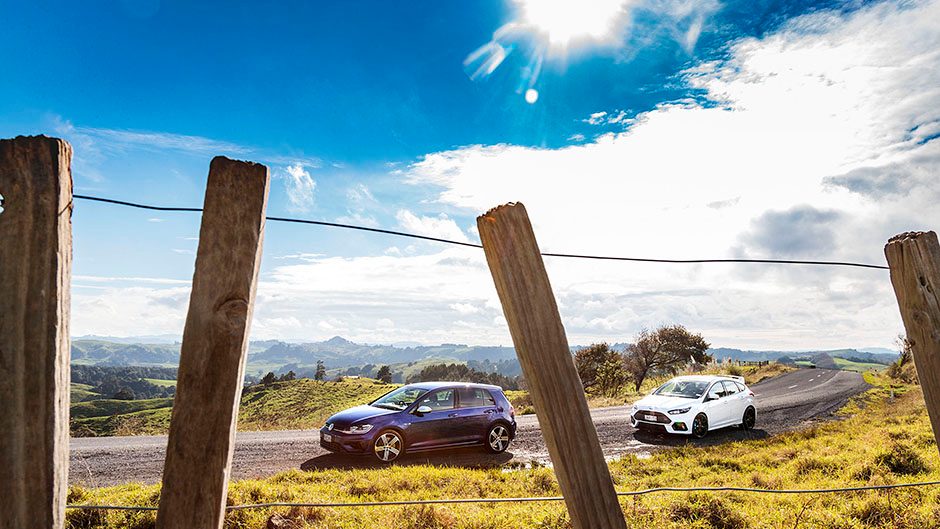
Rapid and refined
VW’s all-important Golf range has just received a few powertrain tweaks, the look’s been freshened with the usual sprucing of lights, bumpers and wheels and there is added specification, with a focus on safety and infotainment systems. The R is better stocked since we last drove it in 2014, now with LED headlights, while the active safety kit features adaptive cruise, AEB, lane keeping and blind spot monitoring. The new look infotainment system supports smartphone integration and the sports seats are trimmed in a mix of cloth and alcantara, though are still comfy rather than hard core. We could live with the manual adjustment too though leather trimmings, heaters and power operation are a $4250 option for those who simply couldn’t.
The R sits lower on sportier springs but adaptive dampers are now standard and so the ride is hardly racy, even when in the Race drive mode. It’s well kitted out for a small package though the price tag is still significant, the manual at $72,890 if you order one though most will go for the $75,390 two-pedal version.
There are a few other options, one being the Performance Pack that includes a new sports exhaust, uprated brakes, a spoiler lip and 19-inch wheels. It’s probably $8000 that most people will end up spending. The standard exhaust is rather muted, even in R mode. It’s possibly a deliberate ploy to get people to upgrade and the Akrapovic titanium system is said to be seven kilos lighter. The special brakes save two kilos too as they adopt a dual cast set-up (alloy hub, steel rotor) which also handles the heat better.
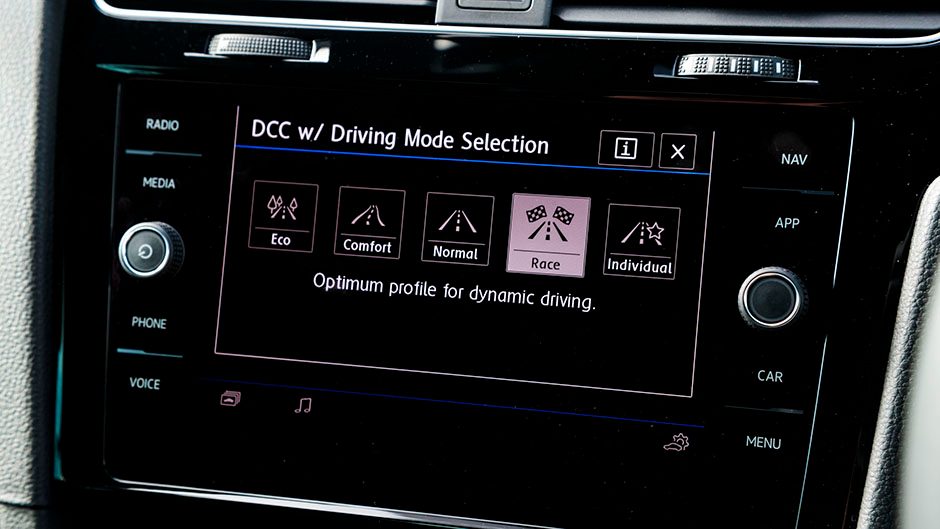
If you’re more into the tech features, $3000 will add the active info display to the instrument panel and VW’s improved infotainment system with a larger screen, gesture and voice control and a bigger hard drive.
The 2.0-litre turbocharged four has been improved, no specific detail as to how, but there’s now 228kW and 400Nm for those who buy the twin-clutch version which features seven forward ratios. This new wet-clutch unit has two oil pumps to ensure constant lubrication in dynamic driving. It also comes with a more effective launch control mode, which goes some way to accounting for the 4.6sec 0-100km/h time. It dials in 4000rpm for the launch, and there’s less slurring of the clutch packs as the torque hits the gearbox and activates the treads. Upshifts are slick and efficient too. The AWD is of the Haldex type, drive sent to the rear when traction and the drive mode demand it. The multi-stage ESP and brakes do the job in lieu of any mechanical locking diff, and also provide a torque vectoring effect to help keep the R on the correct side of the road in bends. Ford’s Focus RS also has a variable AWD system but it has a bit more character. The rear diff gets a more constant feed of torque and it can then divvy that up actively between the left and right rear wheels for better effect in the bends.
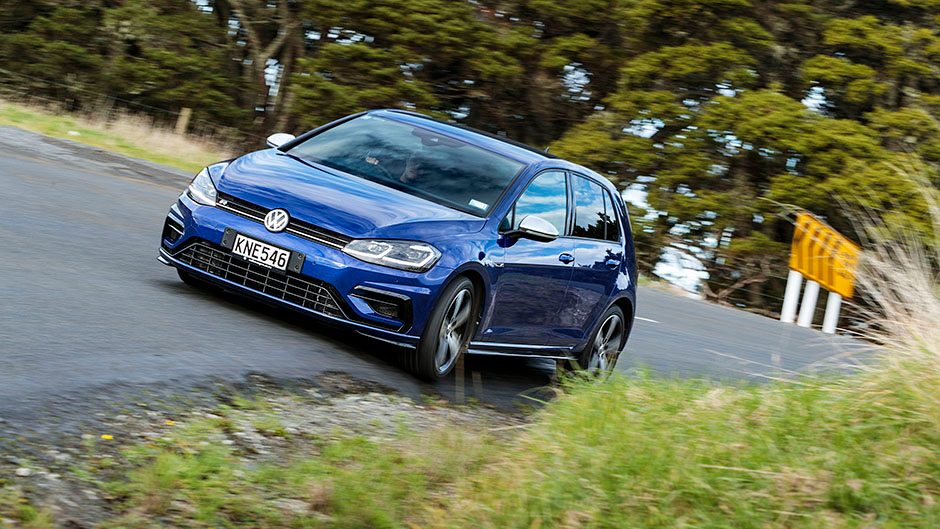
Raw but special
Ford’s Focus RS also has a variable AWD system but it has a bit more character. The rear diff gets a more constant feed of torque and it can then divvy that up actively between the left and right rear wheels for better effect in the bends. There are variable drive modes, one called Drift to get you sideways on track (it’s a little unnerving on road to be honest) and the variable dampers have two settings, a Sport mode (which is the default setting, there’s no Comfort mode) and a locked-solid-for-track action mode. Like the Drift setting, it is best left for circuit outings.
The seats are leather-clad Recaros, the bolsters firm like the ride, and there’s only one transmission on offer, a six-speed manual. The RS’s 2.3-litre engine, a development of the Mustang EcoBoost mill, delivers 257kW and 440Nm, yet even with a launch control setting, and some quick flat shifting (throttle pedal pinned as you dip the clutch and rip the lever through the gate), the RS can’t beat the R to 100km/h, the rapid firing twin-clutch and lighter kerb weight making the R a genuine pocket rocket.
The RS has quick steering like the R, but a wider turning circle, and though there is no auto option, the manual is easy going. And with lots of torque you can skip gears when commuting while it’ll haul around town comfortably in fifth. The ride is sportier than the R’s, and there’s generally more road noise too. On the other hand, the RS features a better engine and exhaust note, especially in Sport mode, where the pipes will burble louder and pop on the overrun. The fast Ford has a hill hold function, rear parking sensors and reversing camera, a multifaceted infotainment system and smart key too. There is ESP and AEB (but no active cruise), and airbags if it all goes wrong. The only option is forged alloys and racier Michelin rubber which this car wears.
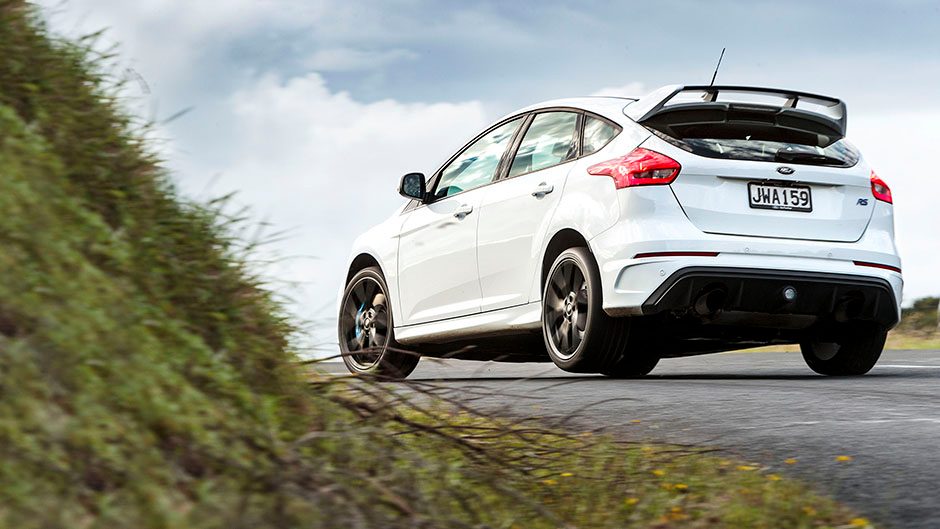
Same-same but different
The persona of each car is reflected in their styling. The Focus is all wings, splitters and aggression, its pumped guards filled with forged alloys and track-ready rubber, its rear diffuser housing two fat pipes that burble and bang. In contrast, the R is a model of subtlety, the proverbial canis lupus in a fleece. It sits a little lower on larger rims, the body work with additional spats and sills while the arrangement of the apertures in the front bumper has been tweaked to help make the R look wider and more planted. While there are five drive modes for the R, ideally you use Normal for everyday running, where this feels as mild-mannered as a base-model TSI, and Race for the fun times. We reckon R mode could be racier still, the suspension firmer and the throttle response sharper.
Driving the R once again we were quickly reminded of how easy this is to pedal. The steering is quick and precise, the R ducking into bends, and with the assured traction and ESP working to keep you buried in the turn, you can pick up the throttle quickly to fire you off the curve. The only thing to watch is how hot you enter corners; easy in and hard out works best. If you’re too eager on the way in, the torque vectoring has its work cut out preventing the front end from slipping wide.
Those who left foot brake will find the ESP cuts in quickly if there’s any overlap of pressure on both pedals. The twin-clutch auto in its racier Sport mode keeps the engine in its happy zone, and with gobs of torque, it feels effortlessly quick. You can cover plenty of ground easily and readily in the R; it’s speed without the sweat. This engine has always had good pull for a 2.0-litre and it feels especially strong in the 2000-5000rpm range. While it revs off to just past 6500, there’s not really the need and this helps it get further on a tank, the average up to 14 at one point, but settling in the low 10s overall.
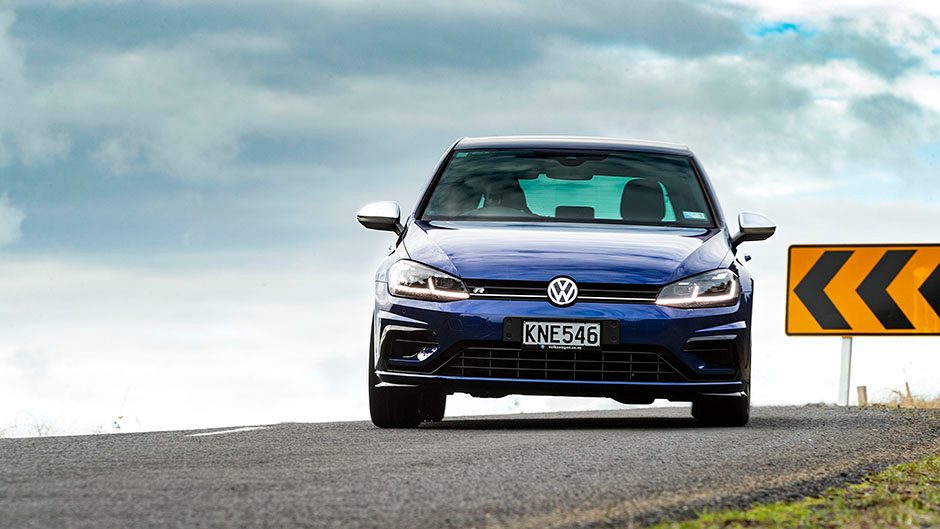
Same-same but different
The persona of each car is reflected in their styling. The Focus is all wings, splitters and aggression, its pumped guards filled with forged alloys and track-ready rubber, its rear diffuser housing two fat pipes that burble and bang. In contrast, the R is a model of subtlety, the proverbial canis lupus in a fleece. It sits a little lower on larger rims, the body work with additional spats and sills while the arrangement of the apertures in the front bumper has been tweaked to help make the R look wider and more planted. While there are five drive modes for the R, ideally you use Normal for everyday running, where this feels as mild-mannered as a base-model TSI, and Race for the fun times.
We reckon R mode could be racier still, the suspension firmer and the throttle response sharper. Driving the R once again we were quickly reminded of how easy this is to pedal. The steering is quick and precise, the R ducking into bends, and with the assured traction and ESP working to keep you buried in the turn, you can pick up the throttle quickly to fire you off the curve. The only thing to watch is how hot you enter corners; easy in and hard out works best. If you’re too eager on the way in, the torque vectoring has its work cut out preventing the front end from slipping wide.
Those who left foot brake will find the ESP cuts in quickly if there’s any overlap of pressure on both pedals. The twin-clutch auto in its racier Sport mode keeps the engine in its happy zone, and with gobs of torque, it feels effortlessly quick. You can cover plenty of ground easily and readily in the R; it’s speed without the sweat. This engine has always had good pull for a 2.0-litre and it feels especially strong in the 2000-5000rpm range.
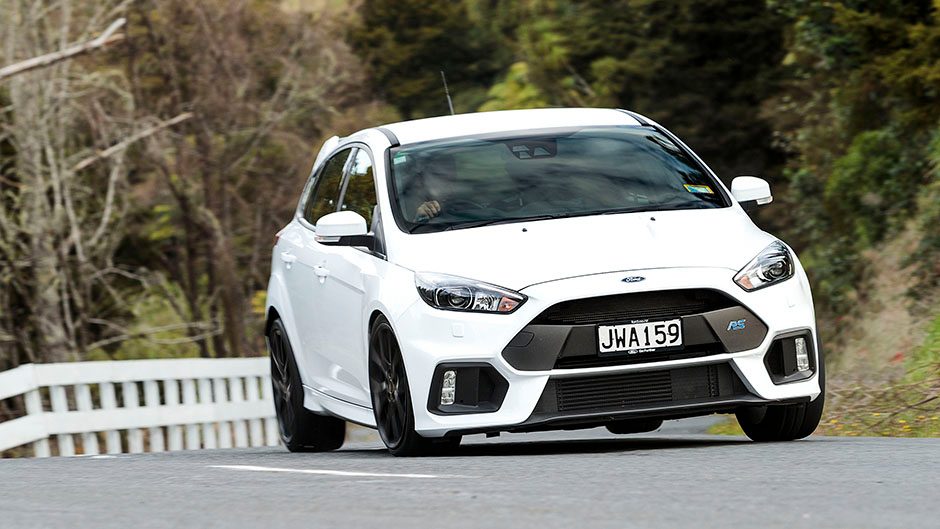
While it revs off to just past 6500, there’s not really the need and this helps it get further on a tank, the average up to 14 at one point, but settling in the low 10s overall. The suspenders, firmed in Race mode, keep things level and compliance is never an issue; it’s just not bothered by unruly road surfaces.
While the R is quick and undemanding, the RS is energising. Like the R it has quick steering but it’s also brimming with vitality. With steering this good we can live with the occasional tramlining on rough roads. It hustles the front end into and around bends more determinedly. The Ford can carry more curry into a turn, the RS biting the tarmac fiercely, helped by the rear diff shuffling the torque to the outside wheel to keep the front end locked on line. Keep a bit of steering lock on past the corner exit, add a bit of gas and the rear end will help straighten the ship, adding another dimension to the drive. Sport mode is about right for road use, throttle response sharper and the ESP backed off. The torque vectoring by brake is almost superfluous. You do feel more of the bumps but they don’t seem to bully the Focus and the payback is superior body control; quick direction changes worry it not.
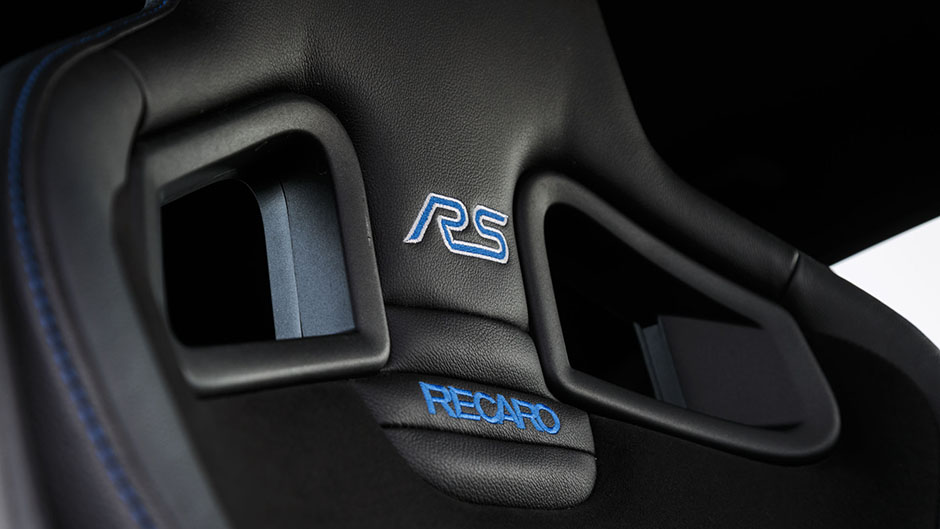
Some might find the job of changing gears quaint in these times and sidestep the RS, while others will see it as another reason to love this car. The clutch is meaty with a defined bite point and pedal placement makes the job easy, as does the gear shift quality. You can round up most roads in quick enough fashion in fourth and fifth gears, dipping to third occasionally. The 2.3-litre has a beefy midrange, but also feels strong up top. Strong enough that you rev it harder and occasionally clip the limiter in second doing so if you’re a bit too keen. It’s thirstier though, around 2.0L/100km worse than VW. The brakes are solid performers, with more bite than the Golf R’s.
The one thing we don’t like about the RS is the seat height, it’s simply too elevated, where you can delve lower in the R. These big Recaros also rob some of the rear seat leg room. There’s more occupant space in the back of the Golf, though both have similar amounts of boot space, just enough to be practical.
The RS is getting a tweak for its last year of production with the fitment of a Quaife mechanical LSD up front. This should help to sort power-on understeer and torque steer, though neither is a genuine issue in the RS. It’s likely to make its presence felt in maximum attack track driving.
Ford NZ is contemplating offering this car here as a special edition final run sort of model and to that we say yes please. What is assured is that RS availability is coming to an end. So if you’ve been dithering, you’d better make up your mind quickly; cars like this don’t come along often. While some might make the case that the VW would be easier to live with, we’d rather cosy up to the more focused Ford.
| Model | Ford Focus RS | Price | $72,990 |
| Engine | 2261cc, IL4, T/DI 257kW/440Nm | Drivetrain | 6M, AWD |
| Fuel Use | 8.1L/100km | C02 Output | 190g/km |
| 0-100km/h | 4.72sec | Weight | 1565kg |
| Model | VW Golf R | Price | $75,390 |
| Engine | 1984cc, IL4, T/DI, 228kW/400Nm | Drivetrain | 7D, on-demand AWD |
| Fuel Use | 7.0L/100km | C02 Output | 163g/km |
| 0-100km/h | 4.63sec | Weight | 1499kg |


